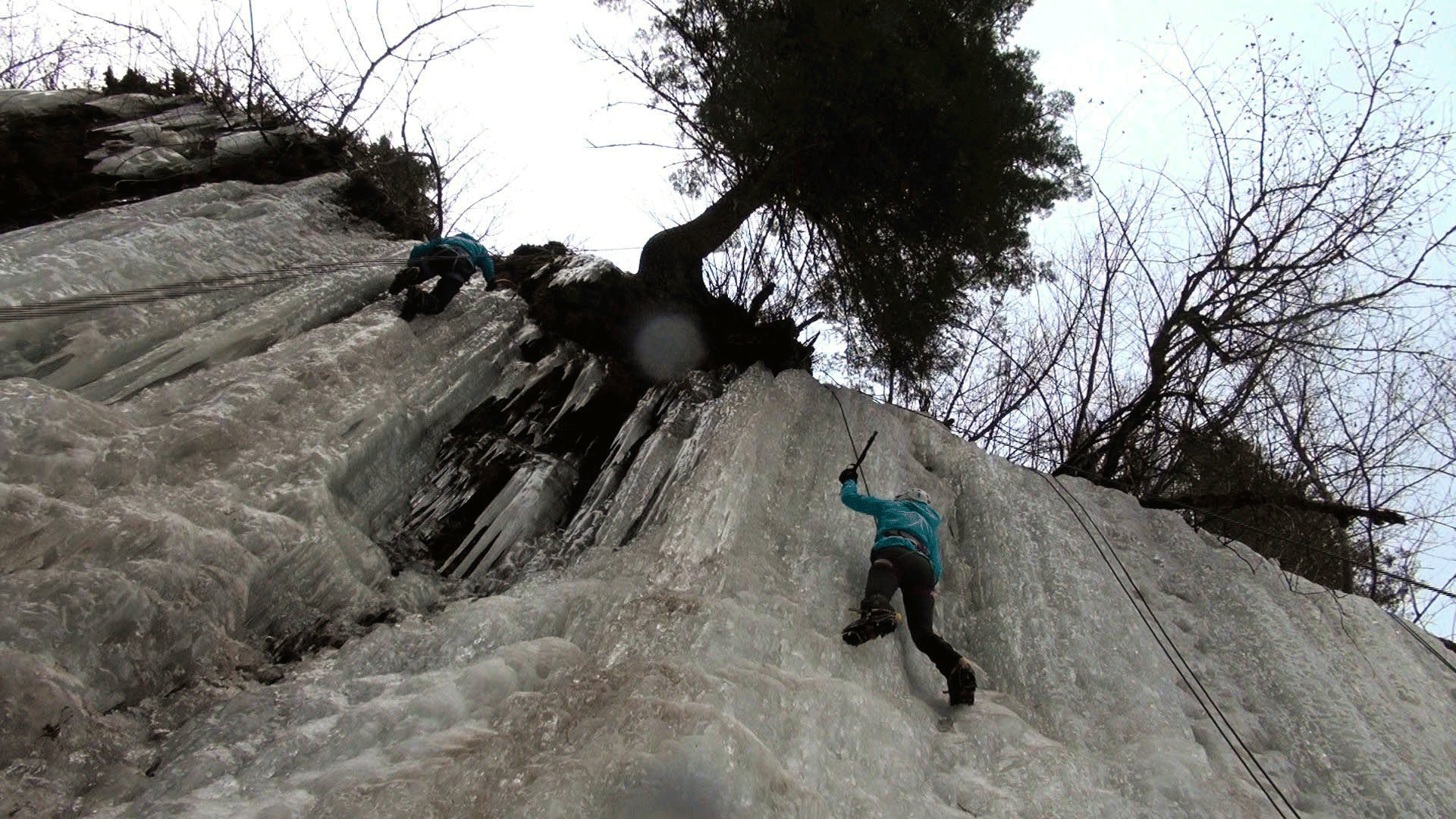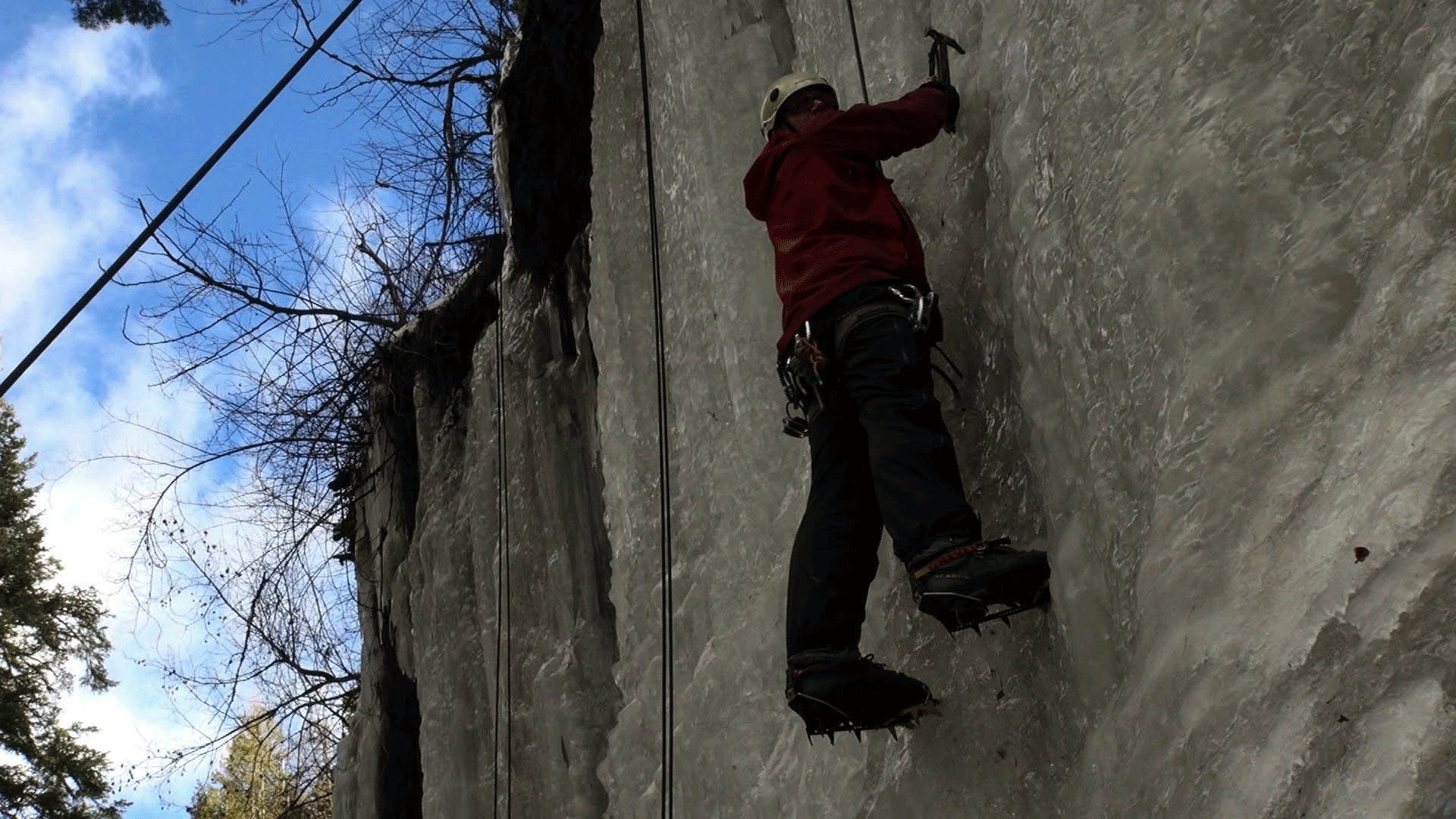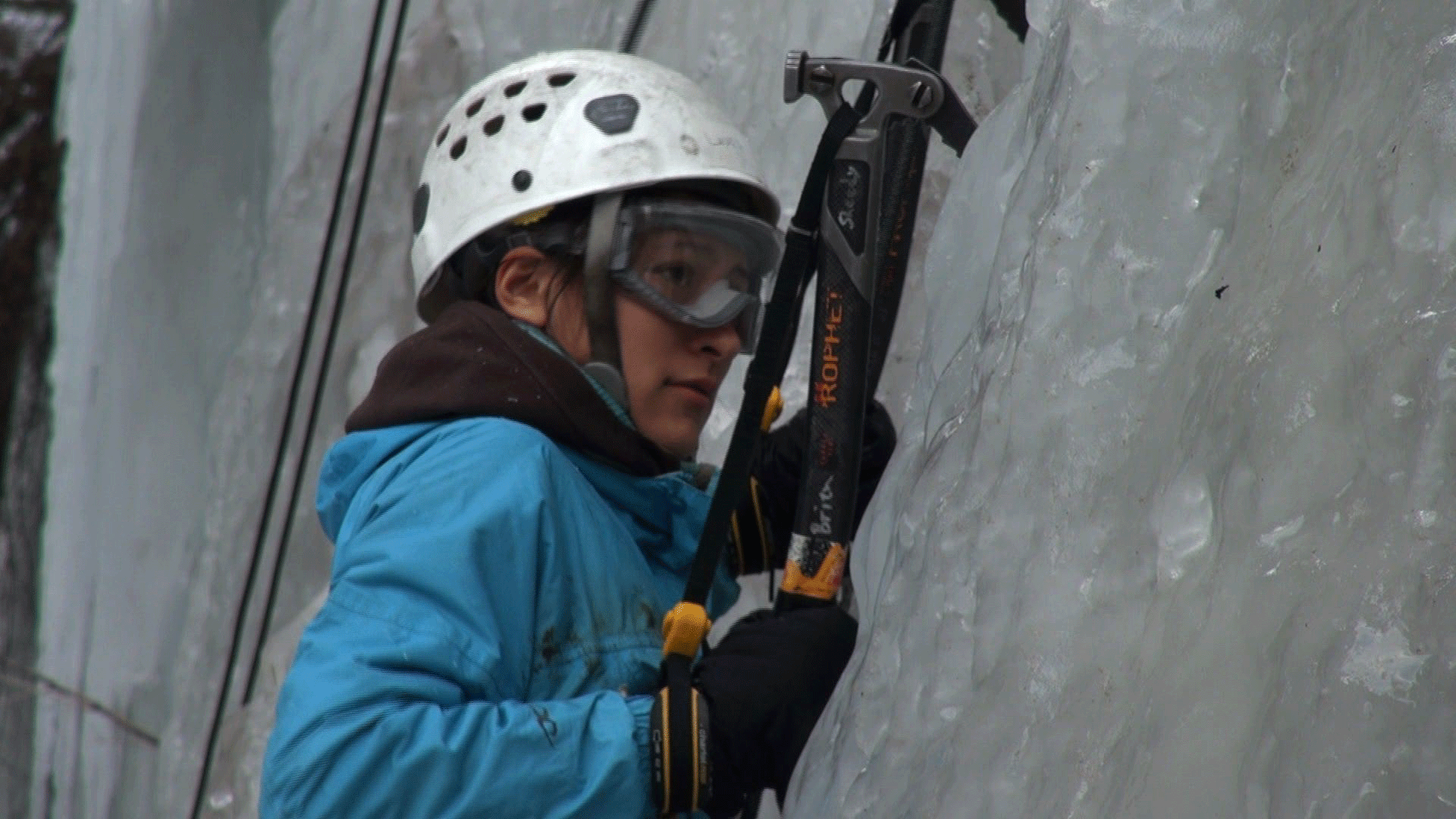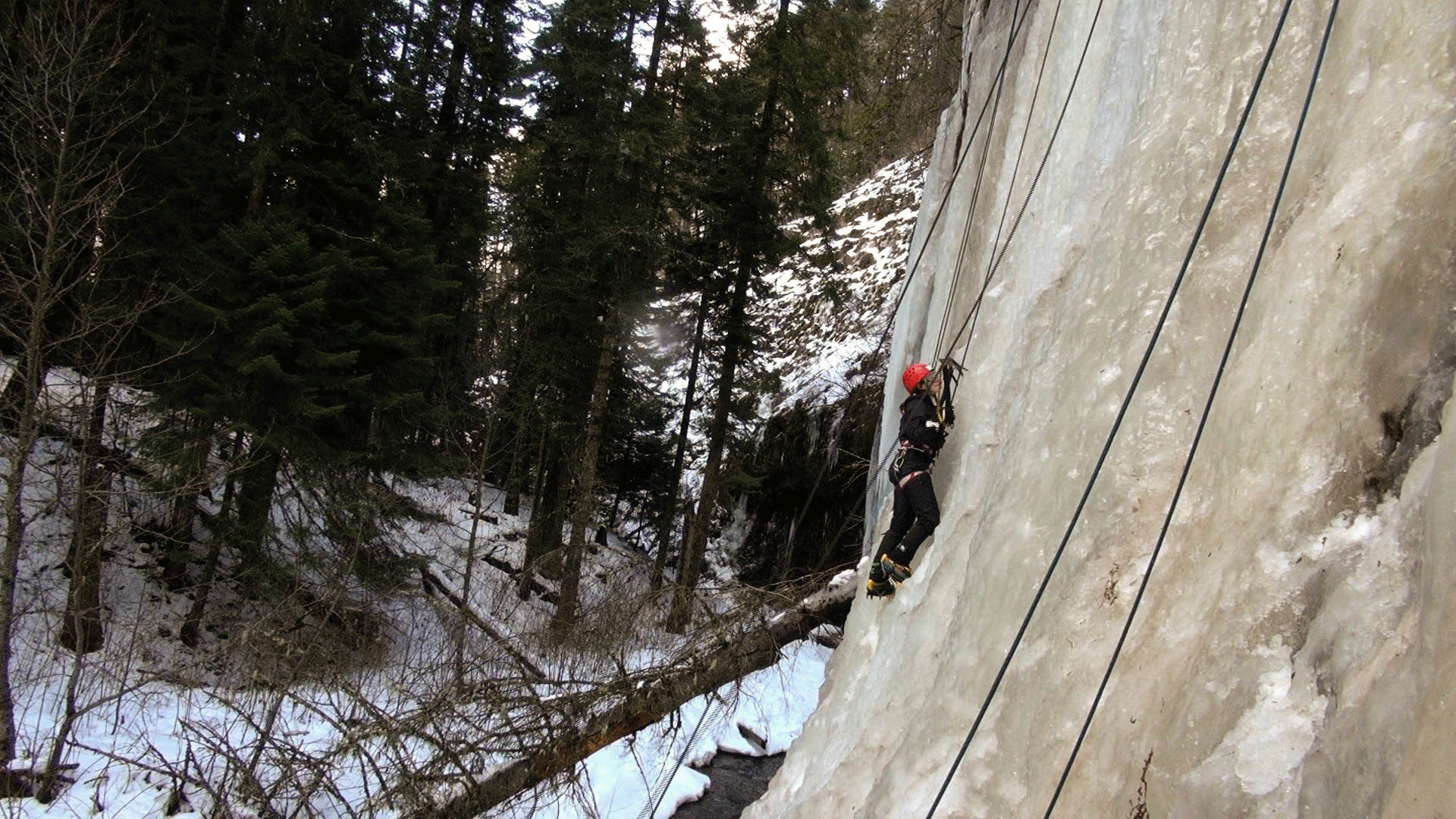Ice Climbing
Air Date: Week of March 7, 2014

Freshmen Laura Rey and Emma Massie are on their first ice-climbing trip. Both want to continue ice climbing in the future. Some outdoor recreationalists are worried that climate change could threaten some ice climbing destinations. (Courtney Flatt)
For people with the slippery hobby of ice-climbing, cold winter weather is essential. And as Courtney Flatt from EarthFix reports, climate change is making frozen ice-walls more unpredictable in the Pacific northwest.
Transcript
CURWOOD: It's Living on Earth, I'm Steve Curwood. In the central and eastern United States, this has been the winter that refuses to end. But these past few months have been warmer than usual for much of the rest of the world, including the Pacific northwest region of North America. The changing weather offers folks in Washington state who love ice climbing fewer opportunities to practice their slippery sport. So that is why, when Courtney Flatt of the public media collaborative EarthFix, heard that a remarkable ice wall near Walla Walla, Washington had frozen up nicely, she clamped on her crampons and headed out.
[RIVER FLOWING]
FLATT: High up in Washington’s Blue Mountains, behind trees and across the Touchet River, is what locals call the Weeping Wall. Water seeps through the permeable basalt and can freeze on the cliff’s moss-covered face. When the conditions are right, that creates a curtain of ice that is irresistible to ice climbers.
[CLIMBING SOUNDS]
FLATT: Today a group of Whitman College students are taking turns scaling the 50-foot wall.
Brien Sheedy directs Whitman’s Outdoor Program. He’s been bringing students here to climb the Weeping Wall for 13 years.

Brien Sheedy, director of Whitman College's Outdoor Program, teaches the students the basics of ice climbing. Sheedy and fellow climbers have anchored bolts to the top of the cliff so that climbers can use ropes to climb the ice face.
SHEEDY: I used to be able to put trips on the schedule when I first started at Whitman College leading groups here. But then the last several years it’s been so unpredictable that we say that we’re going to do ice climbing at some point in the winter, but that it’s going to be condition dependent.
FLATT: Conditions like the right amount of water and cold enough temperatures. Kevin Pogue is a professor at Whitman College. He teaches a class on weather and climate and sometimes helps lead ice-climbing trips with Sheedy. He says temperatures must be cold for an extended time to be able to safely climb the ice.
POGUE: We basically need to get temperatures for a week where low temperatures - it’s in the single digits or low teens, and where it never gets above freezing during the day.
FLATT: Pogue says those conditions could be harder to come by as climate change causes winter temperatures to warm. The region has had a slight warming trend since 1990. That’s according to NOAA’s National Climate Data Center. Pogue says fewer and shorter cold spells means fewer years where the Weeping Wall – and other ice waterfalls in the Pacific Northwest – will form.

Whitman College freshman Laura Rey makes her way up the Weeping Wall, outside Dayton, Wash. This was Rey's first ice climbing trip. (Courtney Flatt)
Take, for example, the Columbia River Gorge. Pogue says ice climbers swarm to this area bordering Washington and Oregon when the gorge’s hundreds of waterfalls freeze. That tends to happen about every five years.
POGUE: What we’ll see is that the Columbia Gorge, maybe it’ll go from being once every five years or so to once every 10 years or so, as things warm up.
FLATT: That could mean ice climbers have to search higher in the mountains for climbing destinations. The people that are dedicated ice climbers will just have to ski in or snowshoe in to get up higher in the mountains where the conditions are colder.
FLATT: With that, brings a whole new set of skills. Plus avalanche awareness. Like ski resorts manufacture snow, it is possible to manufacture ice. But it’s more difficult. Conditions must be colder, for one thing.
One of the premiere ice climbing locations in the U.S. to manufacture ice is Ouray Ice Park in southwestern Colorado. 78 feet of pipe run along the top of a canyon. The pipe sprays water onto the rock walls nightly. That creates 250 climbing routes. Kevin Koprek manages the park. He says climate change is a concern for the ice climbing industry. Koprek says the ice park is in the process of installing equipment to monitor temperature and UV rays in the canyon.
KOPREK: We’d like to move forward having as much information as possible and try to identify trends and use that information as we develop practice and policy operating the ice park.
[ICE CLIMBING]
FLATT: Back at Washington’s Weeping Wall, Brien Sheedy – who’s climbed Mount Everest twice – says one of the best parts of this climb is its accessibility. You can see it from the side of the road on the drive up to Bluewood Ski Area.
Sheedy says, if the ice doesn’t form here as often, he may take students on more trips to climb ice in crevasses on Mount Baker. That’s about a seven-hour drive from the college. The Weeping Wall is about 45 minutes away. On this day, the warm weather makes the climbing easy. And wet.

(Courtney Flatt)
SHEEDY: I think this might be it because we’re going to lose an awful lot. We would need another prolonged one to two week cold spell to get it to form back up again.
FLATT: The students on this trip are hoping to see that cold spell roll in. This is freshman Emma Massie’s first ice climbing trip. Her clothes are soaked from the water that’s dripped from the ice wall. But the conditions aren’t going to keep her away.
EMMA: So normally when climbing season is over, slash winter happens, you can’t rock climb outside. But this opens up a whole new winter sport.
FLATT: She just hopes climate change doesn’t get in the way of her plans.
I’m Courtney Flatt outside Dayton, Washingon.
CURWOOD: Courtney reports for the public media collaborative, EarthFix.
Links
Living on Earth wants to hear from you!
Living on Earth
62 Calef Highway, Suite 212
Lee, NH 03861
Telephone: 617-287-4121
E-mail: comments@loe.org
Newsletter [Click here]
Donate to Living on Earth!
Living on Earth is an independent media program and relies entirely on contributions from listeners and institutions supporting public service. Please donate now to preserve an independent environmental voice.
NewsletterLiving on Earth offers a weekly delivery of the show's rundown to your mailbox. Sign up for our newsletter today!
 Sailors For The Sea: Be the change you want to sea.
Sailors For The Sea: Be the change you want to sea.
 The Grantham Foundation for the Protection of the Environment: Committed to protecting and improving the health of the global environment.
The Grantham Foundation for the Protection of the Environment: Committed to protecting and improving the health of the global environment.
 Contribute to Living on Earth and receive, as our gift to you, an archival print of one of Mark Seth Lender's extraordinary wildlife photographs. Follow the link to see Mark's current collection of photographs.
Contribute to Living on Earth and receive, as our gift to you, an archival print of one of Mark Seth Lender's extraordinary wildlife photographs. Follow the link to see Mark's current collection of photographs.
 Buy a signed copy of Mark Seth Lender's book Smeagull the Seagull & support Living on Earth
Buy a signed copy of Mark Seth Lender's book Smeagull the Seagull & support Living on Earth

